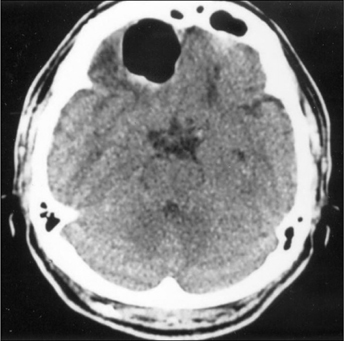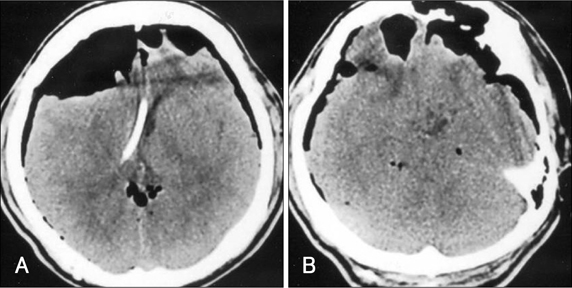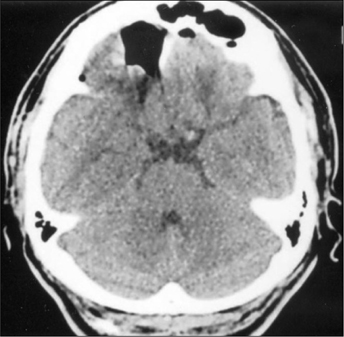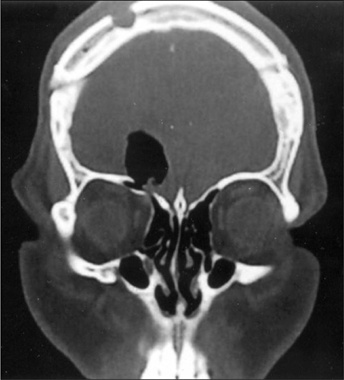J Korean Neurotraumatol Soc.
2009 Dec;5(2):106-108. 10.13004/jknts.2009.5.2.106.
Delayed Tension Pneumocephalus due to Rupture of the Pneumocyst
- Affiliations
-
- 1Department of Neurosurgery, Myongji Hospital, Kwandong University College of Medicine, Goyang, Korea. psc710@kwandong.ac.kr
- KMID: 1427368
- DOI: http://doi.org/10.13004/jknts.2009.5.2.106
Abstract
- Tension pneumocephalus is an unusual delayed presentation of trauma. This case is presentation of a young man who suffered sudden deterioration of mental status from the rupture of the preexisting pneumocyst. He had a history of basal skull fracture, had a ventriculoperitoneal shunt placed due to posttraumatic hydrocephalus and had also undergone the repairing operation of basal skull defect at another hospital. The successful treatment of tension pneumocephalus and persistent pneumocyst at our hospital is described. The neurosurgeon must be aware the possibility of delayed pneumocyst formation and tension pneumocephalus in patients who experienced basal skull fracture quite a long time ago.
Figure
Reference
-
1. Arbit E, Shah J, Bedford R, Carlon G. Tension pneumocephalus: treatment with controlled decompression via a closed water-seal drainage system. Case report. J Neurosurg. 1991; 74:139–142.2. Cartwright MJ, Eisenberg MB. Tension pneumocephalus associated with rupture of a middle fossa encephalocele. Case report. J Neurosurg. 1992; 76:292–295.3. Iplikcioglu AC, Bek S, Bikmaz K, Basocak K. Tension pneumocyst after transsphenoidal surgery for rathke's cleft cyst: case report. Neurosurgery. 2003; 52:960–962.
Article4. Cho HL, Han YM, Hong YK. Tension pneumocephalus after transsphenoidal surgery: report of two cases. J Korean Neurosurg Soc. 2004; 35:536–538.5. Lunsford LD, Maroon JC, Sheptak PE, Albin MS. Subdural tension pneumocephalus. Report of two cases. J Neurosurg. 1979; 50:525–527.6. McClay JE, Carreno O, Gupta A, Willner A. Treatment of Postcraniotomy Tension Pneumocephalus via Endoscopic Closure of the Nasofrontal Recess. Skull Base Surg. 1998; 8:221–224.
Article7. Michel SJ. The Mount Fuji sign. Radiology. 2004; 232:449–450.
Article8. Sasani M, Ozer FA, Oktenoglu T, Tokatli I, Sarioglu AC. Delayed and isolated intraventricular tension pneumocephalus after shunting for normal pressure hydrocephalus. Neurol India. 2007; 55:81–82.
Article9. Satapathy GC, Dash HH. Tension pneumocephalus after neurosurgery in the supine position. Br J Anaesth. 2000; 84:115–117.
Article10. Thompson TP, Levy E, Kanal E, Lunsford LD. Iatrogenic pneumocephalus secondary to intravenous catheterization. Case report. J Neurosurg. 1999; 91:878–880.
- Full Text Links
- Actions
-
Cited
- CITED
-
- Close
- Share
- Similar articles
-
- Two Cases of Delayed Tension Pneumocephalus
- A Case of Intracerebral Tension Pneumocephalus
- What should an intensivist know about pneumocephalus and tension pneumocephalus?
- Delayed Tension Pneumocephalus Following Intraoperative Cerebrospinal Fluid Leakage Repair
- Tension Pneumocephalus Following Eyebrow Aneurysmal Surgery






